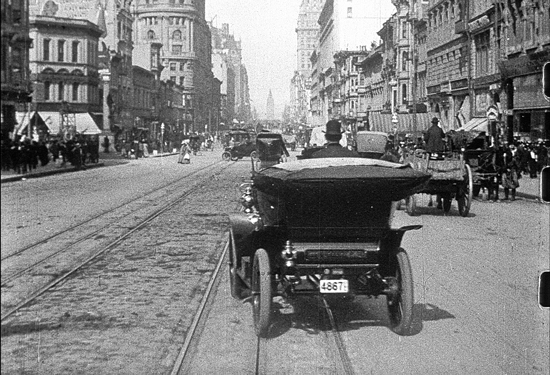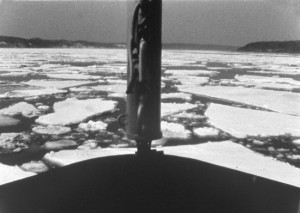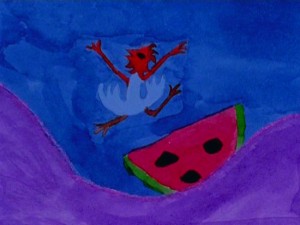Next Wednesday, October 24, I will be hosting a program of six short films selected from the National Film Registry at the Cinema Arts Centre at Huntington, Long Island.
This program indicates some of the breadth of the National Film Registry. The six shorts we will be showing span the years 1906–1996, and include an actuality, two animated shorts, a documentary, an amateur film, and an experimental film. The shorts are both silent and sound, B&W and color, and were filmed on 35mm and 16mm. We’re very lucky to have Ben Model, who will accompany two of the silent films on piano.
A Trip Down Market Street (12 min) 1906 – 35mm
In the first years of cinema, filmmakers traveled the world looking for locations to photograph. The four Miles Brothers, who made A Trip Down Market Street, were one of the first to bring movies to the West Coast. This film, intended to celebrate their new motion picture studio, placed a camera on the front of a Market Street cable car. For years historians thought the film may have been photographed in 1905, but through detective work by David Kiehn, a more accurate date was established two years ago. And that’s what makes this film so poignant today.
Study of a River (16 min) 1996 – 16mm
An experimental film by Peter Hutton, head of the cinema program at Bard. A former merchant marine, Hutton shoots landscape films that evoke the early days of cinema. Shot over several months, this title focuses on the Hudson River near Poughkeepsie.
Popeye the Sailor Meets Sindbad the Sailor (16 min) 1936 – 16mm
One of the most popular animated characters, Popeye the Sailor first appeared in 1919. He became a movie star in 1933, when Betty Boop introduced him to the screen in Popeye the Sailor Man. Gruff but lovable, Popeye appeared in dozens of shorts made by the Fleischer Brothers, Max and Dave, in their studio in New York. This was his first color film, a Technicolor extravaganza twice as long as his usual cartoons. It was a phenomenal hit when it was released, with some theaters even billing it as their featured attraction.
Scratch and Crow (5 min) 1995 – 16mm
An animated film by Helen Hill. She studied at CalArts and Harvard, and taught film in Nova Scotia before moving to New Orleans with her husband. Her work is quirky and exuberant, with bold colors and a strong sense of humor. She is a great example of “do it yourself” filmmaking, and became a role model for a new generation of animators who wanted to express themselves outside of the studio system.
The Jungle (22 min) 1967 – 16mm/DVD (TBC)
An unusual and gripping documentary about teen gangs in Northeast Philadelphia, The Jungle was initiated by Harold Haskins, an activist searching for a solution to increasing violence in underprivileged neighborhoods. Rather than hire outsiders who would impose their own narratives on local teens, Haskins recruited gang members to tell their own story. He had them trained in shooting, directing, and editing film, giving them the opportunity to tell their own story about gang violence from the inside. Rough in points, The Jungle gives an early account of what would evolve into hip hop culture.
Pass the Gravy (20 min) 1928 – 16mm
A silent short starring Max Davidson, supervised by Leo McCarey and photographed by George Stevens. McCarey worked with just about every significant film comedian, from Harold Lloyd to Cary Grant, and was responsible for teaming Laurel and Hardy. Davidson was a Jewish ethnic comedian who starred in a dozen or so films for the Hal Roach Studio, where McCarey ran the shorts department—and in the process defined what would become sitcoms. It’s a really funny film about feuding neighbors, a prize chicken, and a Sunday afternoon feast that turns sour.
Tickets are $10 Members / $15 Public (includes reception)
Tickets also available by calling 800-838-3006, or at the CAC Box Office





